This morning my wife, Laura, and daugher, Elyssa, and I got up and drove to Tarkio, Missouri, land of some of the most interesting roads I’ve ever seen.

Our purpose for this 88 mile drive was to attend the 10th Annual Wing Nuts Flying Circus!
 I received a flyer in the mail a couple weeks ago that advertised fun and adventure for aviation enthusiasts. Count me in! My wife and I have made a couple of trips there over the past couple of years. On our first flight to Tarkio (Gould Peterson Memorial Airport – K57), we met a guy named Sam Graves, and he showed us around the airfield. There wasn’t anything extraordinary about the airfield, other than a guy who seemed deeply in love with aviation. He showed us a hangar that had two military trainers, which were amazing. Then he took us to the upper level of the hangar, where he told us the local flying club met regularly. It had a nice bar-like set up. Off the top upper level of the hangar was a large deck, and what looked like an air traffic control tower.
I received a flyer in the mail a couple weeks ago that advertised fun and adventure for aviation enthusiasts. Count me in! My wife and I have made a couple of trips there over the past couple of years. On our first flight to Tarkio (Gould Peterson Memorial Airport – K57), we met a guy named Sam Graves, and he showed us around the airfield. There wasn’t anything extraordinary about the airfield, other than a guy who seemed deeply in love with aviation. He showed us a hangar that had two military trainers, which were amazing. Then he took us to the upper level of the hangar, where he told us the local flying club met regularly. It had a nice bar-like set up. Off the top upper level of the hangar was a large deck, and what looked like an air traffic control tower. 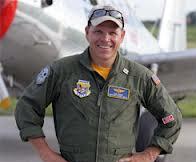 He told us that the tower used to be at Offut Air Force Base. Laura and I climbed the tower and looked out. It was quite a novelty. Later, he gave us an invitation to come back down to visit them when they have their air show.
He told us that the tower used to be at Offut Air Force Base. Laura and I climbed the tower and looked out. It was quite a novelty. Later, he gave us an invitation to come back down to visit them when they have their air show.
My first desire was to fly to the event but in the end, I opted to drive. Trust me; flying there is easier than driving there. By the time we got there, police and the EMS had blocked off the main drive to the air field, which runs along side of the runway so we had to find a back way in. Laura, Elyssa and I took all kinds of paths. One dirt road we took ended at a river with no bridge across. The dirt road was for one lane only and was over-grown with grass so we had to back the car out in reverse for at least ½ a mile. Someone else had the same bright idea that we had so there were two cars backing out of this wonderful road. To say the road was minimum maintenance would be a stretch. On to a different set of paths and 45 minutes after we arrived at Tarkio, we made it to the air field. What an adventure.
Nonetheless, once we arrived, I was really glad we came down. Before coming down to Tarkio, I had coordinated with Darren Koehn, a feller Skyhawk Flying Club member, to meet at the show. Darren and I have flown together on a couple of occasions; he was my safety pilot as I worked on my instrument rating. It was nice to see a familiar face when we were looking at the rows of planes that attendees had flown in. We had a nice conversation then we parted ways.
While looking at the many planes that were flown down to the show, I saw a bright orange bi-plane that piqued my interest. Sitting behind the tail of the plan was the apparent owner. I asked if I could peek inside. After giving his approval, he stopped over and introduced himself as Greg Schildberg from Greenfield, IA. I know Schildbergs of Greenfield as they operate several rock quarries across Iowa. It was great to meet him and to check out his Meyer bi-plane. He is an aviation enthusiast and the president of the Iowa Aviation Museum in Greenfield, IA. It’s a very neat exhibit if you ever get the chance to see it.
Dennis Oliver was another man I met who was resting in the back seat of a Super Decathlon, which is a tandem aerobatic plane. He’s a farmer from Williamsurg, IA. I suspect he’s done very well in his career as a farmer as he’s got two other planes at home and a 4000 ft. runway to go with them. He also told me that he raises camels. In writing this posting, I did a little background check on him and found out that in 1980, he set a Guinness World Record with the most take-offs and landings in one day, 138!
Some childhood memorys came to light when I saw Glen and Linda Anderson from Winterset, IA. I grew up with their son, Brad Little. They fly a Cessna 172 based in Creston, IA. We chatted about life and flying and just caught up since the last time we ran into each other.
Laura, Elyssa and I took pictures of planes, enjoyed some brats, and then headed back for home. Did I mention that there was an airshow?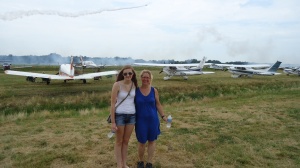 Well, there was a fantastic show which we enjoyed immensely. But frankly, even more than watching the airshow, I enjoyed the camaraderie that fellow pilots share in their love for planes. Get out and do something that you love. I’m always amazed by the friendships I’ve formed and the people I’ve met. What an adventure!
Well, there was a fantastic show which we enjoyed immensely. But frankly, even more than watching the airshow, I enjoyed the camaraderie that fellow pilots share in their love for planes. Get out and do something that you love. I’m always amazed by the friendships I’ve formed and the people I’ve met. What an adventure!



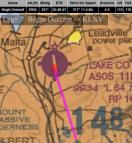
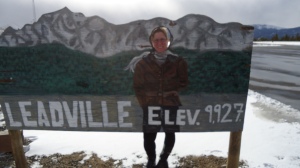
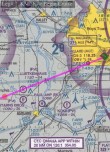 re up-to-date on Fltplan.
re up-to-date on Fltplan.